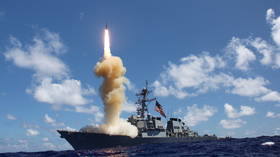Top White House adviser threatens Russia & China with as-yet-nonexistent US hypersonic missiles

Deploying hypersonic missiles to Europe and Asia will deter Russia and China and strengthen Washington’s hand in arms control talks, says National Security Advisor Robert O’Brien. Trouble is, the US doesn’t have such missiles yet.
“We’re developing hypersonic weapons, we’re developing ballistic missile delivery systems that will keep America safe,” O’Brien said on Wednesday, at an event hosted by the Hudson Institute. These are the missiles, according to the adviser, that will “defend our allies, that will deter China, and we’ll deploy the same missiles if necessary in Europe, to deter the Russians.”
It’s classic “peace through strength.”
President Donald Trump’s top security adviser made the statement in the context of a question about the US’ exit from the Intermediate-Range Nuclear Forces (INF) treaty in August last year, saying that China, which was not party to it, had developed and deployed missiles of its own.
Beijing supposedly used these missiles to create “anti-access/area denial” (A2AD, in Pentagon jargon) to “keep our ships and our navy away from our allies in the region and out of China – out of the sphere of influence that China would like to have,” O’Brien said.
Also on rt.com ‘In the spirit of goodwill’: Moscow won’t deploy controversial 9M729 missiles in European Russia if NATO reciprocates, says PutinHis statement comes just days after Russian President Vladimir Putin offered to refrain from deploying missiles the US objected to – but which Moscow insists are still compliant with the INF treaty – out of Europe “in the spirit of goodwill,” so long as NATO does the same.
Though the US cited accusations – without evidence – that Russia had supposedly violated the INF to initiate its exit from the treaty, O’Brien’s predecessor John Bolton was quite open about the INF being a Cold War relic that did not reflect “a new strategic reality out there,” specifically with China in mind.
O’Brien was likewise open about the US wanting to deploy these new missile systems as part of a negotiating strategy to secure a new arms control treaty with Moscow and Beijing.
“We think that by deploying these weapons not only will we deter an attack, but it will also put us in a posture to have real arms control in the future, just like we deployed the Pershing and the cruise missiles to Europe in the ‘80s to get the Soviets to come to the table,” he said.
Also on rt.com What’s ‘verifiable’? Extension of US-Russia nuclear New START treaty hinges on wordThe talk of a planned deployment of hypersonic missiles to Europe comes less than a week after O’Brien announced the US Navy would arm the new Virginia-class submarines and Zumwalt-class destroyers with the superweapons.
“Eventually, all three flights of the Arleigh Burke-class destroyers will field this capability,” O’Brien said, according to Breaking Defense. This apparently caught the Navy by surprise, as there were no budget plans to retrofit the aging destroyers with a technology that does not yet exist.
That’s the other trouble with O’Brien’s announcements, as the Army and the Navy are still working on developing the actual hypersonic missile, and don’t expect to field the first land battery before 2023 at the earliest – with the sea-launched version taking even longer. While there have been a couple of tests of a glide vehicle, the booster for it is reportedly still in the design stage.
“Our goal is to have an early capability in the mid ‘20s,” Vice-Admiral Johnny Wolfe, director of the Navy’s Strategic Systems Programs, told Breaking Defense in April. “We’re trying to take a methodical approach to this, as we work through this to make sure we get it right.”
Meanwhile, the Zumwalts – futuristic designs costing $8 billion apiece, only three of which have been built so far – have “cost too much, done too little, and the Pentagon’s rhetoric on them falls far short of reality,” according to the Project on Government Oversight (POGO), a US watchdog.
Think your friends would be interested? Share this story!













